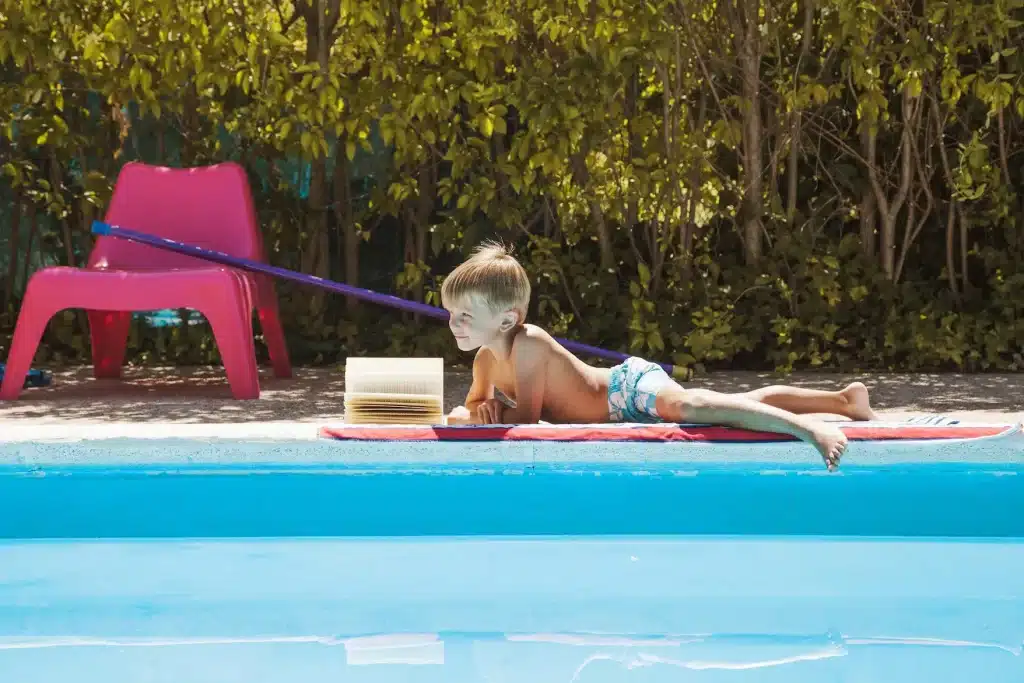A swimming pool liner is renowned for its watertightness and resistance, but it needs regular maintenance and appropriate cleaning to preserve its qualities and aesthetic appearance. Here are 2 golden rules for preserving your liner: balanced water and regular pool maintenance.

Your pool liner makes your pool watertight. Its primary function is to prevent water from seeping into the ground, while protecting the structure. It's made of PVC to resist UV rays and chemicals. So it's an essential part of your installation! On average, a liner lasts between 10 and 15 years. Its composition, which can be thicker or thinner, varnished or reinforced, requires appropriate maintenance and cleaning to preserve its durability.
A clean pool and clear water help preserve your liner for the long term. You can find our tips for cleaning your pool here. In high season, you should clean your liner almost daily, or at least once a week. A thorough cleaning is necessary during wintering and when your pool is restarted.
To care for your liner, you can alternate between manual and automatic tools:
The key to cleaning your liner is to use products adapted to the material of your liner (classic liner, reinforced PVC, with or without varnish...).
On a daily basis, you can use natural products such as white vinegar for the water line, and baking soda to remove stains. Finally, soda crystals help to remove grease and are a powerful cleaner.
There are several types of stains on liners:
It indicates the presence of metal particles in the water, such as copper. We recommend using a "special metal" flocculant to remove them.
Green spots are the sign of too much sun exposure and you need to act quickly to prevent the dirt from sticking. Start by lowering the water level, then scrubbing and brushing the stains with a sponge. Use "special waterline" cleaners. Protect your pond from the sun during hot weather.
They reveal abnormal humidity under the liner, which causes bacteria to proliferate. First, apply a shock treatment, then filter the water continuously for 48 hours. If the problem persists, your liner is probably no longer waterproof. Contact your specialist without delay.
If your liner is less than 10 years old, the presence of these stains can mean water that is too hard. In this case, take a tH measurement to check the water's hardness. If your liner is more than 10 years old, it may be deteriorated and at the end of its life.
Your pool water is out of balance. Check the pH and readjust it if necessary. Act quickly before algae appears, which is more difficult to treat and requires the use of more chemicals.
Do you use a chlorine treatment?
If you are using a chlorine treatment, you should never put the pebbles in direct contact with the liner as this will cause discolouration or staining of the surface. In general, manufacturers recommend putting the chlorine pebbles in the skimmers or in a floating basket.
The right water balance extends the life of your liner, protecting it from chemical attack, mineral deposits and discoloration. With clean, healthy water, you protect all your pool's equipment, especially the liner in direct contact with chemicals and UV rays. Water balance boils down to pH, TH (water hardness) and TAC (water alkalinity).
Here are some examples of the impacts of water imbalance:
The liner of a swimming pool is exposed to many elements (chemicals, debris and UV rays) on a daily basis, making it fragile. To preserve its aesthetic appeal and waterproofing function, it's important to take good care of it on a daily basis, using the right cleaning products and tools. However, the best way to preserve it remains to maintain balanced water, with the right dosage of water disinfection products. The ICO Pool connected water analyzer helps you keep your water clean and healthy every day, and guides you in your daily pool maintenance.
| Cookie | Duration | Description |
|---|---|---|
| cookielawinfo-checkbox-analytics | 11 months | This cookie is set by GDPR Cookie Consent plugin. The cookie is used to store the user consent for the cookies in the category "Analytics". |
| cookielawinfo-checkbox-functional | 11 months | The cookie is set by GDPR cookie consent to record the user consent for the cookies in the category "Functional". |
| cookielawinfo-checkbox-necessary | 11 months | This cookie is set by GDPR Cookie Consent plugin. The cookies is used to store the user consent for the cookies in the category "Necessary". |
| cookielawinfo-checkbox-others | 11 months | This cookie is set by GDPR Cookie Consent plugin. The cookie is used to store the user consent for the cookies in the category "Other. |
| cookielawinfo-checkbox-performance | 11 months | This cookie is set by GDPR Cookie Consent plugin. The cookie is used to store the user consent for the cookies in the category "Performance". |
| viewed_cookie_policy | 11 months | The cookie is set by the GDPR Cookie Consent plugin and is used to store whether or not user has consented to the use of cookies. It does not store any personal data. |